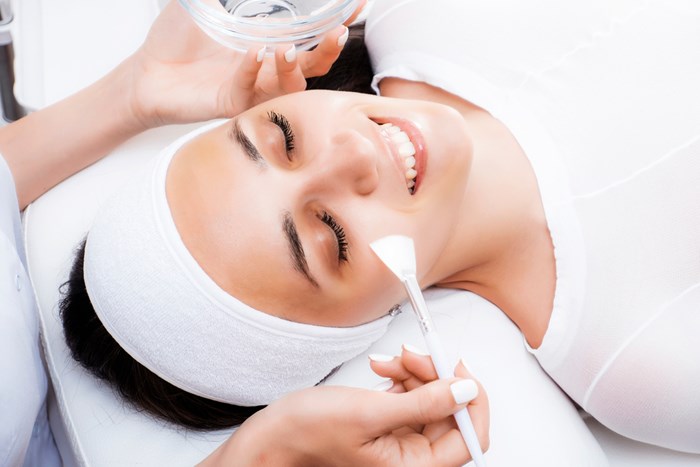To peel or not to peel, that is the question! Well first of all ask yourself why peel? There are so many facial rejuvenation options available these days that the choice can be dazzling. Here at our medical spa we try to make the decision-making easier by guiding our patients using their area of concern as a starting point. What are you trying to achieve? How long do you want to take for recovery and downtime (seems like a silly question but some people such as brides to be are on a deadline and others are not and do not need to worry about healing timescales)? What is your budget etc ? How intensive do you want your treatment to be? There are many procedures that can achieve the same thing, some do in intensively and fast, but take longer to heal, and others do it gradually, more frequently and with less downtime.
Today I want to talk about peeling or chemical peels to be more specific. These chemical agents come in different types and strengths and do different things. For example our Clear Choice acid peels do the following: Glycolic – provides deep exfoliation, Jessners – removes pigmentation, TCA – erases scars and provides anti-aging, Lactic – gives moisturization, Salicylic – clears out pores and acne, Isomer – removes pigmentation. While these peels work alone they can be combined so multiple issues can be tackled. I also use the VI Peel which is five custom medium-depth peels that treat five concerns: aging, acne/acne scarring, sensitive skin, pigmentation and the body.
As you see chemical peels have a wide range of treatment and some people prefer them because they might be scared of needles or lasers. (They do not have to be but I want everyone to feel comfortable with the solutions we offer). The best thing about peeling is that it removes the old, dead, damaged layers of skin (depending on the strength used) and requires a up to two weeks to peel from start to finish. This is different for everyone and depends on their rate of healing and is usually a day of redness after the treatment, then dry leathery darkening, then peeling and finally pink rosy soft skin. Obviously the deeper the peel the more intense the healing and peeling. Some types of peel might not even peel at all but that doesn’t mean they are not working! They are peeling at a micro-level we cannot see but they are renewing the skin nevertheless.
During and after the peeling process it is vital to keep the skin hydrated by drinking lots of water, eating healthily with lots of protein to help the skin renew and finally using sunscreen. This protects the baby skin, you don’t want to hyperpigment when you have been doing your best to remove freckles and age spots! Some people prefer to peel in the winter when the sun is less intense but as we live in Colorado, that is never! Hats, sunglasses and sunscreen at all times after a peel.
Come in and see us at Invigorate Advanced Aesthetics in Centennial, Colorado to start your chemical peels journey.


 Alexis Pepple2024-03-09Robyn & her team are truly fantastic. They have come up with a whole skin care routine for me. I love knowing that I have a plan to accomplish the skin care goals that I want. I also love their new membership program. It is such a great value I would highly recommend.
Alexis Pepple2024-03-09Robyn & her team are truly fantastic. They have come up with a whole skin care routine for me. I love knowing that I have a plan to accomplish the skin care goals that I want. I also love their new membership program. It is such a great value I would highly recommend. Alanna Rohloff2024-03-01I’m feeling as motivated as ever to build muscle and lose body fat, working with Caitlin as my nutritionist and coach. She’s so smart and kind. I also love going into the med spa- it’s beautiful and comfortable. Highly recommend this company to anyone.
Alanna Rohloff2024-03-01I’m feeling as motivated as ever to build muscle and lose body fat, working with Caitlin as my nutritionist and coach. She’s so smart and kind. I also love going into the med spa- it’s beautiful and comfortable. Highly recommend this company to anyone. Elexis Zamora2024-02-26Robyn was Great! She answered all of my questions she was professional and listened to what I wanted my results to be. I got Botox and lip filler. I’m currently four days out and I can see results but still waiting on the Botox to kick in! But overall a clean environment cute spa! And so far I love the way my lips turned out. Great experience!!!
Elexis Zamora2024-02-26Robyn was Great! She answered all of my questions she was professional and listened to what I wanted my results to be. I got Botox and lip filler. I’m currently four days out and I can see results but still waiting on the Botox to kick in! But overall a clean environment cute spa! And so far I love the way my lips turned out. Great experience!!! vibes amanda2024-02-24The work I’ve had done here was truly life changing. Aside from the clinic being so inviting and extremely elegant, the staff is so kind and beyond talented. I’ve gotten my lips done here twice now and both times I’ve gained a new found confidence that has made all the difference in the world in my day to day life. This is the greatest investment I’ve ever made into how I feel about myself and I will continue to get all of my aesthetic work done here. I cannot recommend this place enough!
vibes amanda2024-02-24The work I’ve had done here was truly life changing. Aside from the clinic being so inviting and extremely elegant, the staff is so kind and beyond talented. I’ve gotten my lips done here twice now and both times I’ve gained a new found confidence that has made all the difference in the world in my day to day life. This is the greatest investment I’ve ever made into how I feel about myself and I will continue to get all of my aesthetic work done here. I cannot recommend this place enough! Vicious Vanity Ink Tattoo Studio2024-02-23Caitlin is absolutely amazing! She is very helpful and extremely knowledgeable! She is super supportive and is there to help you every step of the way! I highly recommend Caitlin to assist you in all your wellness and nutritional needs!
Vicious Vanity Ink Tattoo Studio2024-02-23Caitlin is absolutely amazing! She is very helpful and extremely knowledgeable! She is super supportive and is there to help you every step of the way! I highly recommend Caitlin to assist you in all your wellness and nutritional needs! Nikki Cox2024-02-23Do it! You'll love how you look after!
Nikki Cox2024-02-23Do it! You'll love how you look after! Ashley Campbell2024-02-22Everyone at Invigorate is so welcoming and kind. I got a facial with Robyn and she was wonderful and my face feel nice and fresh. Excited to continue to go back back for my other skin care needs.
Ashley Campbell2024-02-22Everyone at Invigorate is so welcoming and kind. I got a facial with Robyn and she was wonderful and my face feel nice and fresh. Excited to continue to go back back for my other skin care needs. Kathy Coffey2024-02-22Wonderful experience
Kathy Coffey2024-02-22Wonderful experience Jenny D2024-02-20Amanda is amazing and made me feel so welcome and cared for!Google rating score: 5.0 of 5, based on 111 reviews
Jenny D2024-02-20Amanda is amazing and made me feel so welcome and cared for!Google rating score: 5.0 of 5, based on 111 reviews
Site navigation
Office hours
Appointments outside these hours available upon request
Monday to Friday – 9am – 6pm
Saturday – closed
Sunday – closed